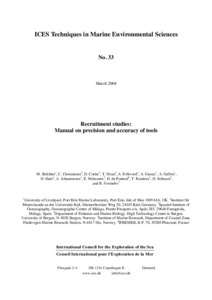Recruitment studies: manual on precision and accuracy of tools.

View/
Average rating
votes
Date
2004Author
Belchier, M.
Clemmesen, C.
Cortes, D.
Doan, T.
Folkvord, A.
Garcia, A.
Geffen, A.
Høie, H.
Johannessen, A.
Moksness, E.
de Pontual, H.
Ramirez, T.
Schnack, D.
Sveinsbo, B.
Status
PublishedPages
35pp.
Metadata
Show full item recordAbstract
This manual is one of the results of the project Precision and Accuracy of Tools in Recruitment
Studies (PARS), financed by the EU (FAIR-CT96–1371). The project PARS is concerned with
improving the methodologies used in investigations and the monitoring of the early life stages
of fish larvae, especially herring and sardine. These are important in both stock assessments and
strategic research intended to improve predictive capability. The project deals with precision
and accuracy issues in two categories of measurements, which together encompass most of the
data that are routinely required from samples of early life stages of fish:
• the growth and condition of individuals;
• the origin of individuals.
Quantitative evaluation of the growth rate and condition of larvae in relation to environmental
conditions at the time of capture is an essential prerequisite for predictive assessment of survival
potential. In particular, the identification of starving or sub-optimally growin.....
Resource URL
http://ices.dk/publications/library/Publisher
International Council for the Exploration of the Sea (ICES)Copenhagen, Denmark
Series;Nr
ICES Techniques in Marine Environmental Sciences;34Document Language
enSustainable Development Goals (SDG)
14.AEssential Ocean Variables (EOV)
Fish abundance and distributionBest Practice Type
Standard Operating ProcedureGuide
ISSN
0903–2606Citation
Belchier, M.; Clemmesen, C.; Cortes, D.; Doan, T.; Folkvord, A.; Garcia, A.; Geffen, A.; Høie,H.; Johannessen, A.; Moksness, E,; de Pontual, H.;. Ramirez, T.; Schnack, D. and. Sveinsbo, B. (2004) Recruitment studies: manual on precision and accuracy of tools. By ICES Techniques in Marine Environmental Sciences, No. 33, 35pp. DOI: http://dx.doi.org/10.25607/OBP-230Collections
 Repository of community practices in Ocean Research, Applications and Data/Information Management
Repository of community practices in Ocean Research, Applications and Data/Information Management